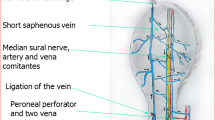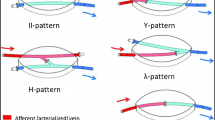Abstract
Arteriovenous loops (AVL) of Corlett are used to provide recipient vessels for complex microsurgical reconstructions in vessel depleted lower limbs. They can be prone to thrombosis, injury during re-dissection, and possible steal phenomenon. We report an approach to improve safety and decrease dissection time in a delayed complex lower limb reconstruction. A 49-year-old male was referred for non-union of a severely comminuted and compound femoral fracture. A vascularised double-barrel fibula flap was planned with a two-team approach. Despite negative bone scans and pre-operative blood tests, infected femoral callus was found intraoperatively. The raised flap was wrapped in silicone sheets to ease re-dissection. At the second reconstructive attempt, after antibiotic therapy, the silicone-wrapped recipient vein was found thrombosed. A delayed reconstruction with an AVL was executed. The contralateral long saphenous vein was harvested and anastomosed end-to-side to the superficial femoral artery and end-to-end to the ipsilateral great saphenous vein close to the saphenofemoral junction. The loop was wrapped in silicone to prevent over-dilatation of the vein and to prevent adherence to tissues for subsequent dissection. The loop was matured for 4 weeks during which Doppler ultrasonography revealed an arterial stenosis requiring balloon angioplasty. Division of the loop and final free fibula flap transfer occurred with no postoperative complications. The use of silicone sheeting has not been previously described to protect the recipient vessels, to facilitate re-operation, and to restrict AVL dilatation secondary to arterial forces. Doppler ultrasonography has also not been described to monitor loop safety. Combined AVL with silicone sheeting and Doppler monitoring improved the speed and safety in this two-stage AVL procedure.
Level of evidence: Level V, therapeutic study.





Similar content being viewed by others
References
Knackstedt R et al (2018) Single-stage versus two-stage arteriovenous loop microsurgical reconstruction: a meta-analysis of the literature. Microsurgery 38(6):706–717
Threlfall GN, Little JM, Cummine J (1982) Free flap transfer–preliminary establishment of an arteriovenous fistula: a case report. ANZ J Surg 52(2):182
Cavadas C (2008) Arteriovenous vascular loops in free flap reconstruction of the extremities. Plast Reconstr Surg 121(2):514–520
Kwei S et al (2004) Early adaptive responses of the vascular wall during venous arterialization in mice. Am J Pathol 164(1):81–89
Charles AK, Gresham GA (1993) Histopathological changes in venous grafts and in varicose and non-varicose veins. J Clin Pathol 46(7):603
Gibbons GH, Dzau VJ (1994) The emerging concept of vascular remodeling. NEJM 330(20):1431–1438
Cowan BD, Langille BBL (1996) Cellular and molecular biology of vascular remodeling. Curr Opin Lipidol 7(2):94–100
Schwartz LB et al (1992) Myointimal thickening in experimental vein grafts is dependent on wall tension. J Vasc Surg 15(1):176–186
Bush HL et al (1986) The natural history of endothelial structure and function in arterialized vein grafts. J Vasc Surg 3(2):204–215
Lin C-H et al (2004) Sixty-five clinical cases of free tissue transfer using long arteriovenous fistulas or vein grafts. J Trauma 56(5):1107–1117
Henn TD et al (2018) One stage versus two-stage arteriovenous loop reconstructions – an experience on 103 cases from a single center. Plast Reconstr Surg 143(3):912–924
Meyer A et al (2015) Results of combined vascular reconstruction by means of AV loops and free flap transfer in patients with soft tissue defects. J Plast Reconstr Aesthet Surg 69(4):545–553
Pribaz JJ, Fine NA (1994) Prelamination: defining the prefabricated flap—a case report and review. Microsurgery 15(9):618–623
Yap KK et al (2018) The vascularised chamber as an in vivo bioreactor. Trends Biotechnol 36(10):1011–1024
Maitz MF (2015) Applications of synthetic polymers in clinical medicine. Biosurface and Biotribology 1(3):161–176
Harris JR et al (1999) Effect of diameter of microvascular interposition vein grafts on vessel patency and free flap survival in the rat model. J Otrolaryngol 28(3):152
Yamane Y et al (2017) Impact of the size mismatch between saphenous vein graft and coronary artery on graft patency. Gen Thorac Cardiovasc Surg 65(1):25–31
Author information
Authors and Affiliations
Corresponding author
Ethics declarations
Ethical approval
All procedures performed in studies involving human participants were in accordance with the ethical standards of the institutional and/or national research committee and with the 1964 Helsinki Declaration and its later amendments or comparable ethical standards. This is a case report. For this kind of study, no ethical approval is required.
Informed consent
Patient signed informed consent regarding publication of their case and photographs.
Conflict of interest
Justin Yousef, Michael W Findlay, and Rostam D Farhadieh declare no competing interests.
Additional information
Publisher's note
Springer Nature remains neutral with regard to jurisdictional claims in published maps and institutional affiliations.
Rights and permissions
About this article
Cite this article
Yousef, J., Findlay, M. & Farhadieh, R.D. Arterialised venous loops and complex flap reconstruction: can silicone and Doppler monitoring make them safer?. Eur J Plast Surg 45, 855–859 (2022). https://doi.org/10.1007/s00238-021-01927-w
Received:
Accepted:
Published:
Issue Date:
DOI: https://doi.org/10.1007/s00238-021-01927-w




